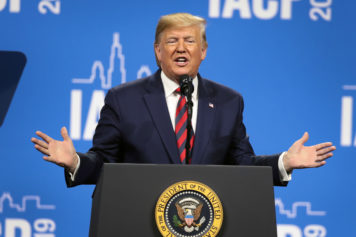
But just what had been done before?
As the Department of Education’s archives tout, over one million African-American and Latino students enrolled in HBCUs during the Obama administration, which outpaced the Bush administration by investing over $3 billion over the course of eight years.
Yet, the relationship remained fractured, thanks in part to a 2009 budget that initially cut $73 million in funding and new credit guidelines enacted by the Department of Education that made it harder for parents to receive Parent PLUS loans. The result: Over 400,000 found themselves rejected from the program while thousands of students, unaware that they could appeal the decision, simply dropped out altogether, dealing a blow to HBCU enrollment rates.
Increasingly stringent financial aid policies and little federal oversight also have affected enrollment, forcing schools including St. Paul College, Lewis College of Business and others to shutter their doors.
After failing to address the lack of dedicated funding, Obama would be accused of being out of touch with the plight of HBCUs. Speaking with the Congressional Black Caucus in early 2015, he faced additional criticism after stating, “We don’t want a situation in which young people are taking out loans, getting in debt, thinking that they’re going to get a great education and then, halfway through, they’re dropping out.”
It was a tone that Thurgood Marshall College Fund President Johnny C. Taylor Jr. lamented. “We just could not believe this was happening under a Black president,” he said. “That was not a response a president should have given. All those things hold true for community colleges, yet he wants to double down on funding them.”
Eager for a change in direction, they’d filed into Trump’s Oval Office hungry for a seat at the table, renewing the debate over the validity of sitting down with an administration that, thus far, has been tone deaf to the needs of minorities. Instead, they’d received a ceremonial photo-op, complete with a far-too-comfortable Kellyanne Conway snapping away while perched on a couch as Trump stood beaming in a sea of brown faces.
But, the meeting left many disenchanted, with Morehouse President John Wilson Jr. later noting, “Given my experience in the Obama administration, I knew this would require an extraordinary announcement. Why? Because I knew that President Obama had invested $3 billion more in HBCUs in his first six years than President Bush invested in his final six years.
“Instead of the long-awaited executive order containing or signaling any of those outcomes, the key change is a symbolic shift of the White House HBCU Initiative from the Department of Education to the White House,” he sad. “It is not possible to measure the impact of this gesture anytime soon, if ever.”
Morehouse President John Wilson Jr., criticism of the Trump meeting put him at odds with the Morehouse Board of Trustees, who had already decided not to renew his contract. The Board of Trustees officially dismissed Wilson on Monday although he had three months remaining on his contract.
Other HBCU presidents also weighed in on the meeting. “The President was cut short by photo ops and handshakes,” West Virginia State University President Dr. Anthony L. Jenkins said. Nevertheless, I wanted to leave Washington making sure the president and lawmakers understood the value and importance of HBCUs. And our value to the success of this country is undeniable.”
In short, the order itself was largely ceremonial, a transfer of power with HBCUs now falling under the jurisdiction of the White House, where it’d been during the Bush administration.
Their fate also lies in the hands of the very woman unaware of why HBCUs were even created. The embattled Secretary of Education is now responsible for a massive network of universities and the same public schools she’d previously deemed unsuitable for her own children.
As the waiting game for an official budget continues, to date, Trump has expressed an interest in ramping up military spending but has given few details on anything else. If the proposal put forth by House Republicans is any indicator, 62 percent of cuts would come directly from low-income programs, a move that could place additional Pell Grant funding on the chopping block.
“Pell grants to students at HBCUs are down. Direct loans to our students are down. Graduate subsidies have been eliminated,” Hampton University President William R. Harvey said. “In addition to student support, overall support to Black colleges is down.
“In general, the meetings were a troubling beginning to what must be a productive relationship.”
Lacking the deep endowments enjoyed by their white counterparts, HBCUs have largely been left to fend for themselves throughout most of their 150-year history. Yet, they’ve still managed to thrive, consistently producing productive alumni.
It’s a legacy that will continue, whether the new administration makes good on its promises or not. Howard University SGA President Allyson Carpenter made that point clear to The Fader when she stated, “We’re very protective of our HBCUs and we all came here for a reason. In my mind, HBCUs are supposed to be the protectors of marginalized people. That’s what I feel is our primary obligation. If HBCUs aren’t here to stand up for people who can’t speak up for themselves or who are being ignored, then it brings up this relevancy question. It’s not about just educating Black people, it’s about creating a generation of leaders.”
For now, HBCUs will continue to do what they do best. As Dillard University President Walter M. Kimbrough recently wrote, “We are the crucible of Black leadership development. It is impossible to discuss any aspect of the Black experience in America without involving graduates of HBCUs. When the heroes and sheroes are honored every Black History Month, most don’t realize that many are products of these institutions.”


